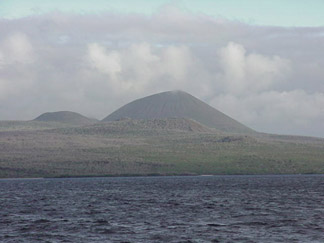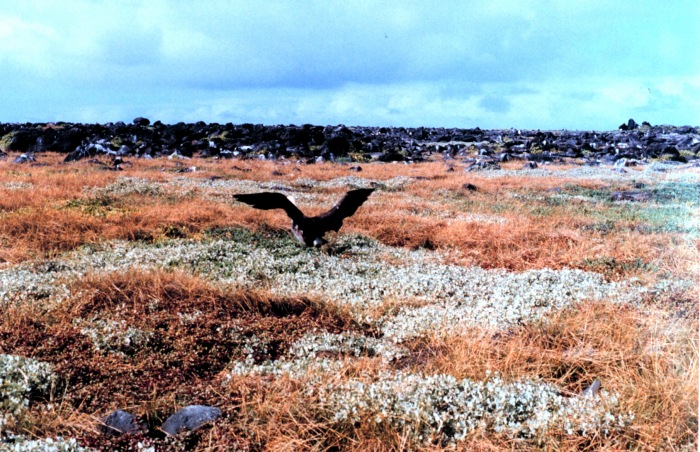Geography and Geology
Floreana
 The
island of Floreana spans across an area that is approximately 12 km x 15 km
and rises to a peak elevation of 640 m. Floreana possesses some of
the oldest lavas (1.5 million years) that are found on the volcanic Galapagos
archipelago, making Floreana on the older islands. It is covered with
many young pyroclastic cones, which are produced when lava is thrown into
the air explosively. Floreana itself remains an active volcano and
represents one extreme of the range of lava compositions encountered on the
islands. Basalts from active volcanic sites are distinctely more "alkalic"
in composition as opposed to the more "theoleiitic" compositions produced
by most volcanoes. Floreana magmas are produced at shallower depths
in th earth's mantle and by smaller extents of melting than in the rest of
the Galapagos. Moreover, Floreana is one of the few islands with a
reliable fresh water supply--an artesian spring at the base of Cerro
Olympus.
The
island of Floreana spans across an area that is approximately 12 km x 15 km
and rises to a peak elevation of 640 m. Floreana possesses some of
the oldest lavas (1.5 million years) that are found on the volcanic Galapagos
archipelago, making Floreana on the older islands. It is covered with
many young pyroclastic cones, which are produced when lava is thrown into
the air explosively. Floreana itself remains an active volcano and
represents one extreme of the range of lava compositions encountered on the
islands. Basalts from active volcanic sites are distinctely more "alkalic"
in composition as opposed to the more "theoleiitic" compositions produced
by most volcanoes. Floreana magmas are produced at shallower depths
in th earth's mantle and by smaller extents of melting than in the rest of
the Galapagos. Moreover, Floreana is one of the few islands with a
reliable fresh water supply--an artesian spring at the base of Cerro
Olympus.
photograph by Charles F. Urbanowicz [2000].
Espanola

Espanola is one of the smaller Galapagos Islands measuring 7 km x 14
km and reaching an elevation of about 200 m. Espanola is the oldest
Galapagos Island dating back 3.25 million years. The island represents
the northern two-thirds of a once larger volcano and appears to have been
subjected to the same tectonic processes that have disrupted other islands
of the Galapagos. The low elevation of Espanola makes it dry and inhospitable
to terrestrial life, though it is still a favorite spot for many seabird
species.
Rosalind Cohen, NODC,
NOAA
Research
Climate
Geoindicators
Home
 The
island of Floreana spans across an area that is approximately 12 km x 15 km
and rises to a peak elevation of 640 m. Floreana possesses some of
the oldest lavas (1.5 million years) that are found on the volcanic Galapagos
archipelago, making Floreana on the older islands. It is covered with
many young pyroclastic cones, which are produced when lava is thrown into
the air explosively. Floreana itself remains an active volcano and
represents one extreme of the range of lava compositions encountered on the
islands. Basalts from active volcanic sites are distinctely more "alkalic"
in composition as opposed to the more "theoleiitic" compositions produced
by most volcanoes. Floreana magmas are produced at shallower depths
in th earth's mantle and by smaller extents of melting than in the rest of
the Galapagos. Moreover, Floreana is one of the few islands with a
reliable fresh water supply--an artesian spring at the base of Cerro
Olympus.
The
island of Floreana spans across an area that is approximately 12 km x 15 km
and rises to a peak elevation of 640 m. Floreana possesses some of
the oldest lavas (1.5 million years) that are found on the volcanic Galapagos
archipelago, making Floreana on the older islands. It is covered with
many young pyroclastic cones, which are produced when lava is thrown into
the air explosively. Floreana itself remains an active volcano and
represents one extreme of the range of lava compositions encountered on the
islands. Basalts from active volcanic sites are distinctely more "alkalic"
in composition as opposed to the more "theoleiitic" compositions produced
by most volcanoes. Floreana magmas are produced at shallower depths
in th earth's mantle and by smaller extents of melting than in the rest of
the Galapagos. Moreover, Floreana is one of the few islands with a
reliable fresh water supply--an artesian spring at the base of Cerro
Olympus.